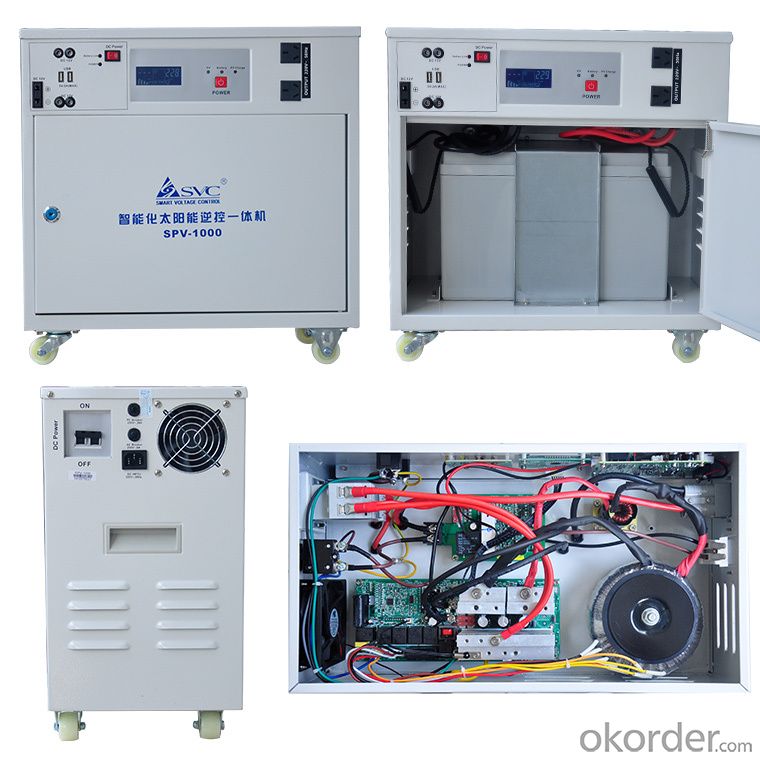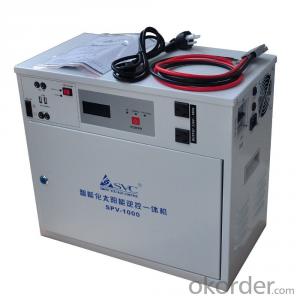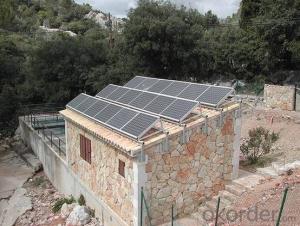Solar Power System ALL-IN-ONE 480W Pure Sine Wave AC/DC Output LCD/LED 12V/24V Solar Power System
- Loading Port:
- China main port
- Payment Terms:
- TT OR LC
- Min Order Qty:
- 20 carton
- Supply Capability:
- 10000 carton/month
OKorder Service Pledge
OKorder Financial Service
You Might Also Like
ALL-IN-ONE 480W Pure Sine Wave AC/DC Output LCD/LED 12V/24V Solar Power System

| Model | SPV-600 | SPV-800 | SPV-1000 | SPV-1500 | |
| Rated power: | 360W | 480W | 600W | 1000W | |
| storage battery: | 12V(optional:24V) | ||||
| specifications of charging | |||||
| charging mode | PV charging and mains charging | ||||
| PWM solar controller: | voltage | 12V(optional:24V) | |||
| current | 30a(Max)(depends on the power of solar panels) | ||||
| PV maximm voltage | 12V system(potional:24V system) | ||||
| 25V | |||||
| hybrid charging | PV charging current:when I>15A,AC charging current is off | ||||
| PV charging current:when I>15A,AC charging current is 5A | |||||
| PV charging current:when I≤15A,AC charging current is 10A | |||||
| DC output system | |||||
| Charging port /USB | 5V/2A(Total)/ 2 units | ||||
| output port of DC | 12V/1.5A/ 3 units | ||||
| AC Mode | |||||
| Input voltage | 145-275VAC | ||||
| Input frequency | 48-54Hz(50HZ),Same s AC | ||||
| Output voltage | 200-240VAC | ||||
| Short Circuit | Breaker | ||||
| Inverter Mode | |||||
| Output voltage | 220VAC±5% | ||||
| Output frequency | 50±1% Hz(Auto detection) | ||||
| Output P.F | ≥0.6 | ||||
| Output wave form | Pure Sine Wave | ||||
| Transfer time | Typical 2-6ms,10ms max | ||||
| Overload capability | 110% Shut down within 60sec. | ||||
| 120% Shut down within 5sec. | |||||
| Short Circuit | ≥20ms System shut down automatically | ||||
| priority principle of mains and inversion | intelligent and automatic recongnition | ||||
| protection | protectings of output overload,output short circuit,inpot over voltage,input under voltage and over-temperature | ||||
| specifications of the overall unit | |||||
| dimension(mm) | 455*250*400 | ||||
| Net weight(KG) | 11 | 12 | 14 | 16 | |
| Gross weight(KG) | 12.5 | 13.5 | 16 | 18.5 | |
| display | display mode | LCD+LED | |||
| display information | LCD:working and protection status of inerter,charging status of storage battery | ||||
| LED:indications of working status and PV charging | |||||
| ENVIRONMENT | |||||
| ENVIRONMENT | indoor,or outdoor with waterproof measures | ||||
| Environment of performance: | Temperature 0℃~40℃,Humidity 20%~90%,non condensing | ||||
| Noise Level | Less than 40dB(lm) | ||||
Product Description
 Product introduction:
Product introduction:
High quality low frequency pure sine wave inverter
PWM solar controller
DC power system
Field of application
Solar hybrid photo voltaic system, which possess automatic recognition, intelligent switch over function:applicable to areas where electricity bills are expensive or environmental protection area since this system can transfer solar energy into power efficiently and save mains, like, household solar/wind power system, street lamp soar/wind power system etc.
Detail Description
easy to install, users just need to connect solar panels and batteries to fish installation
Intelligent CPU controlled, modular composition
LED or LCD display, specifications and status of charging and operation are displayed in a direct way, which is convenient to operate
Multifunctional integrated machine, customers don’t need to buy extra controller, charger, AVR, etc.
Room had been reserved for standard configuration of battery(100AH) inside the machine, ans it can also connect to external battery pack to prolong back time. (according to residential sunshine and wind energy source, customers can require a matching number of battery packs)
Applicable to all kinds of loads, like, motors, air conditioners, electronic drills, fluorescent lamps, gas lamps etc.
Apply low frequency pure sine wave circuit design, high stability, low failure rate with a long operational life span(more than 5 years), and easy to maintain.
Protections of low voltage, over voltage, over-temperature, short circuit, overload etc
Process DC power system, which can provide environment power to LEDs, DC fans, radios, mobile phones and other consumption equipment
Details:
- Q:What is the impact of hurricanes on solar panels?
- The impact of hurricanes on solar panels can be significant. The powerful winds that accompany hurricanes have the potential to damage or dislodge solar panels from their mountings, especially if they are not properly secured. This can result in the complete destruction of the panels or render them ineffective in generating electricity. In addition, the debris that is propelled through the air during a hurricane can cause physical damage to the solar panels, such as cracks or shattered glass. This damage can impair the functionality of the panels and reduce their efficiency in converting sunlight into electricity. Moreover, the heavy rainfall that often accompanies hurricanes poses a threat to solar panels. If water infiltrates the panels, it can lead to electrical short circuits or damage to the internal components, rendering them inoperable. Furthermore, hurricanes can lead to power outages, which can affect the functionality of solar panels. If the electric grid is offline, the solar panels may be unable to send excess energy back into the grid or receive power from it, limiting their ability to generate electricity. However, it is important to note that solar panels are designed to withstand various weather conditions, including strong winds and heavy rain. When installed and maintained properly, solar panels have a higher chance of surviving a hurricane with minimal damage. Additionally, advancements in solar panel technology, such as stronger glass and improved mounting systems, are continuously being made to increase their resilience to extreme weather events. In conclusion, while hurricanes can negatively impact solar panels, taking proper precautions and conducting regular maintenance can enhance their durability and make them a viable and sustainable energy option even in areas prone to hurricanes.
- Q:Can solar energy systems be used in powering retirement homes or assisted living facilities?
- Yes, solar energy systems can definitely be used to power retirement homes or assisted living facilities. Solar panels can be installed on the roofs or in open spaces of these facilities to capture sunlight and convert it into electricity. This renewable energy can then be used to power various amenities such as lighting, heating, cooling, and appliances, reducing their reliance on traditional power sources and lowering energy costs. Additionally, solar energy systems are environmentally friendly and sustainable, aligning with the growing trend of integrating green solutions in retirement homes and assisted living facilities.
- Q:Are there any government incentives for installing solar energy systems?
- Yes, there are several government incentives available for installing solar energy systems. These incentives include federal tax credits, state and local rebates, grants, and loan programs. These incentives aim to promote the use of renewable energy sources and help individuals and businesses offset the costs of installing solar panels.
- Q:Can a solar energy system be integrated with other energy sources?
- Yes, a solar energy system can be integrated with other energy sources. This integration is known as a hybrid energy system and is becoming more common as a way to enhance the reliability and efficiency of renewable energy systems. By combining solar energy with other sources such as wind, hydro, biomass, or even traditional fossil fuel generators, a hybrid system can provide a more stable and consistent power supply. This integration allows for energy production even during periods of low solar radiation or when there is no sunlight, ensuring a continuous power supply. Additionally, hybrid systems can also include energy storage technologies, such as batteries, to store excess energy generated by the solar panels for use during times of high demand or when solar energy production is low. Overall, integrating solar energy systems with other energy sources can help optimize energy production, increase reliability, and support the transition to a more sustainable energy future.
- Q:What is the installation process for a solar energy system?
- The installation process for a solar energy system typically involves several steps. Firstly, a site assessment is conducted to determine the suitability of the location for solar panel installation. Then, the necessary permits and paperwork are obtained. Next, the solar panels are mounted on the roof or ground, positioning them to maximize sunlight exposure. Following this, the electrical wiring and components are installed, connecting the panels to an inverter and the existing electrical system. Finally, the system is tested and commissioned to ensure it is functioning properly.
- Q:Can solar energy systems be used in powering art galleries or museums?
- Yes, solar energy systems can indeed be used to power art galleries or museums. Solar panels can be installed on the rooftops or surrounding areas of these buildings to capture sunlight and convert it into electricity. This renewable energy source can provide a sustainable and cost-effective solution for powering lighting, climate control systems, and other electrical needs within art galleries and museums. Additionally, using solar energy can contribute to reducing the carbon footprint of these institutions, making them more environmentally friendly.
- Q:Can solar energy systems be used for powering water pumping systems?
- Yes, solar energy systems can be used for powering water pumping systems. Solar-powered water pumping systems use photovoltaic (PV) cells to convert sunlight into electricity, which can then be used to power water pumps. This provides a sustainable and cost-effective solution for pumping water in remote areas or locations without access to electricity grids.
- Q:Can solar energy systems be used in powering beauty salons or spas?
- Yes, solar energy systems can definitely be used to power beauty salons or spas. Solar energy is a renewable and sustainable source of power that can help reduce the dependence on grid electricity and minimize the carbon footprint of these establishments. By installing solar panels on the roof or other suitable areas, beauty salons and spas can generate their own electricity and reduce their energy costs in the long run. Beauty salons and spas typically require a significant amount of electricity to operate hair dryers, hair straighteners, curling irons, lighting, air conditioning, and other equipment. Solar energy systems can easily meet these power demands, especially during daylight hours when the sun is shining. Excess electricity generated during the day can be stored in batteries or fed back into the grid, ensuring a continuous supply of power at all times. Moreover, solar energy systems can help improve the sustainability and environmental performance of beauty salons and spas. By switching to solar power, these establishments can significantly reduce their carbon emissions and contribute to the fight against climate change. Additionally, using solar energy can help attract environmentally conscious customers who appreciate businesses that prioritize sustainability. In summary, solar energy systems are a viable option for powering beauty salons and spas. They can provide a reliable and sustainable source of electricity, reduce energy costs, and contribute to a greener and more environmentally friendly business operation.
- Q:Can solar energy systems be used for powering sports stadiums?
- Yes, solar energy systems can be used for powering sports stadiums. Many sports stadiums around the world have already implemented solar energy systems to meet a portion or even all of their electricity needs. These systems typically consist of solar panels installed on the stadium roofs or in adjacent areas to harness sunlight and convert it into electricity. The generated energy can then be used to power the stadium's lighting, scoreboard, sound systems, and other electrical equipment. Utilizing solar energy helps reduce the carbon footprint of sports stadiums and promotes a more sustainable and environmentally friendly approach to powering large venues.
- Q:Can solar energy systems be used for powering telecommunications towers or antennas?
- Certainly, solar energy systems are capable of powering telecommunications towers and antennas. Solar power presents a sustainable and dependable energy source that can be harnessed to supply electricity for various purposes, including the operation of telecommunications infrastructure. To function efficiently, telecommunications towers and antennas require a steady and uninterrupted flow of electricity. However, conventional methods of powering these structures, like diesel generators, not only incur high expenses but also contribute to pollution and carbon emissions. Solar energy systems, on the other hand, offer a cleaner and more economical alternative. By installing solar panels on or near the telecommunications tower, sunlight is captured and transformed into electricity through photovoltaic cells. This electricity can be utilized directly to power the tower's equipment or stored in batteries for use during periods of low sunlight. Through the adoption of solar energy, telecommunication companies can reduce their reliance on fossil fuels and decrease operational costs. Furthermore, solar energy systems can be implemented in remote areas where accessing the grid or establishing a reliable power supply can be challenging. In such instances, solar power can provide a viable solution, enabling telecommunication companies to expand coverage and connectivity to underserved regions. In conclusion, solar energy systems prove to be an exceptional option for powering telecommunications towers and antennas. They present a sustainable and cost-effective solution while minimizing environmental impact. With advancements in solar technology, the efficiency and reliability of solar power systems continue to improve, establishing them as a viable choice for the telecommunications industry.
1. Manufacturer Overview |
|
|---|---|
| Location | |
| Year Established | |
| Annual Output Value | |
| Main Markets | |
| Company Certifications | |
2. Manufacturer Certificates |
|
|---|---|
| a) Certification Name | |
| Range | |
| Reference | |
| Validity Period | |
3. Manufacturer Capability |
|
|---|---|
| a)Trade Capacity | |
| Nearest Port | |
| Export Percentage | |
| No.of Employees in Trade Department | |
| Language Spoken: | |
| b)Factory Information | |
| Factory Size: | |
| No. of Production Lines | |
| Contract Manufacturing | |
| Product Price Range | |
Send your message to us
Solar Power System ALL-IN-ONE 480W Pure Sine Wave AC/DC Output LCD/LED 12V/24V Solar Power System
- Loading Port:
- China main port
- Payment Terms:
- TT OR LC
- Min Order Qty:
- 20 carton
- Supply Capability:
- 10000 carton/month
OKorder Service Pledge
OKorder Financial Service
Similar products
New products
Hot products
Hot Searches
Related keywords































